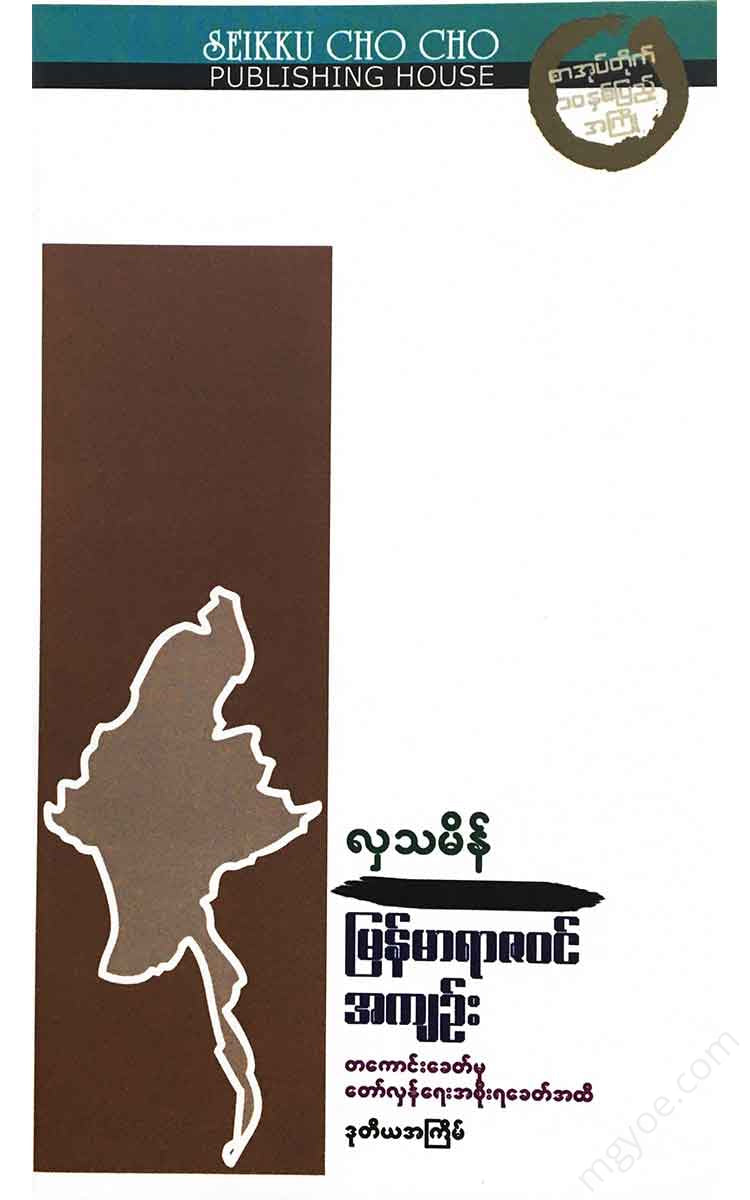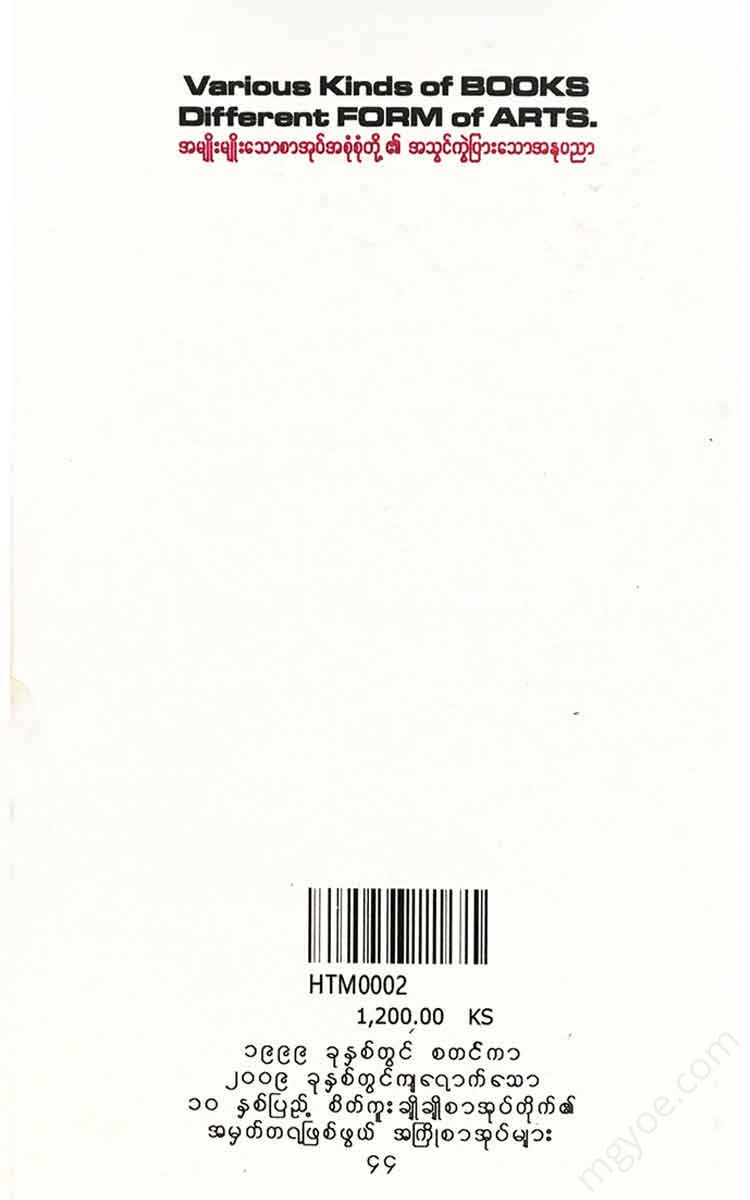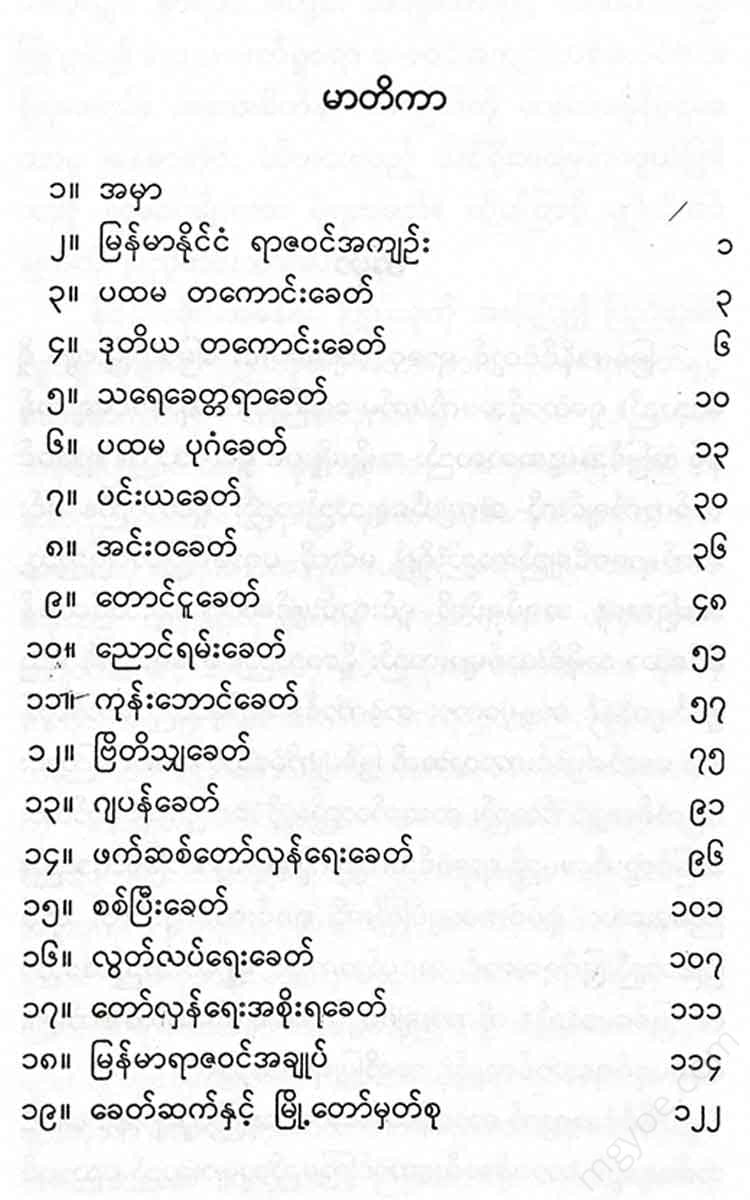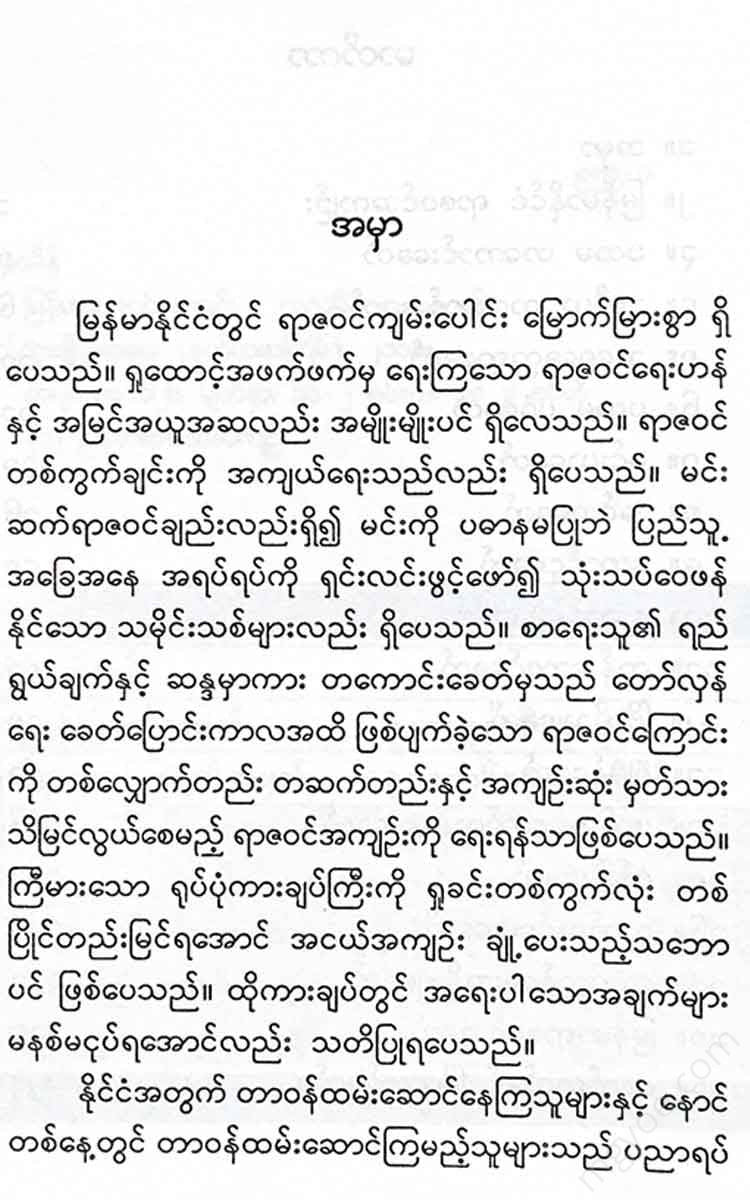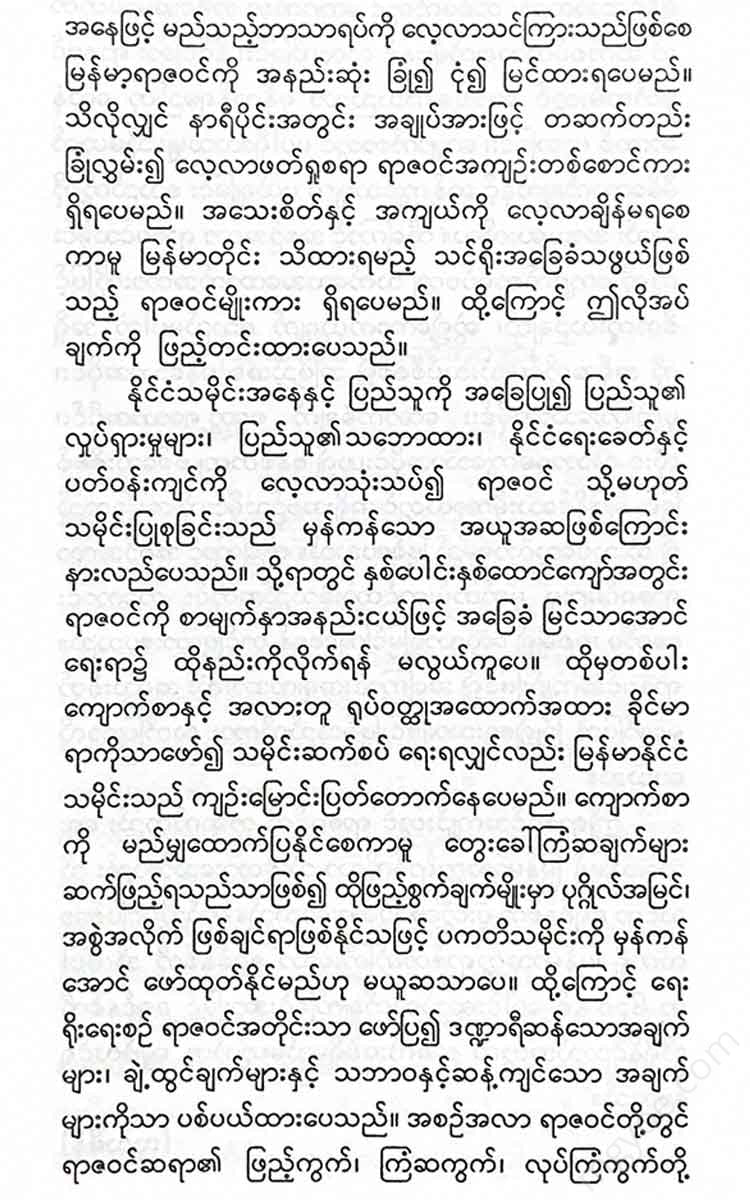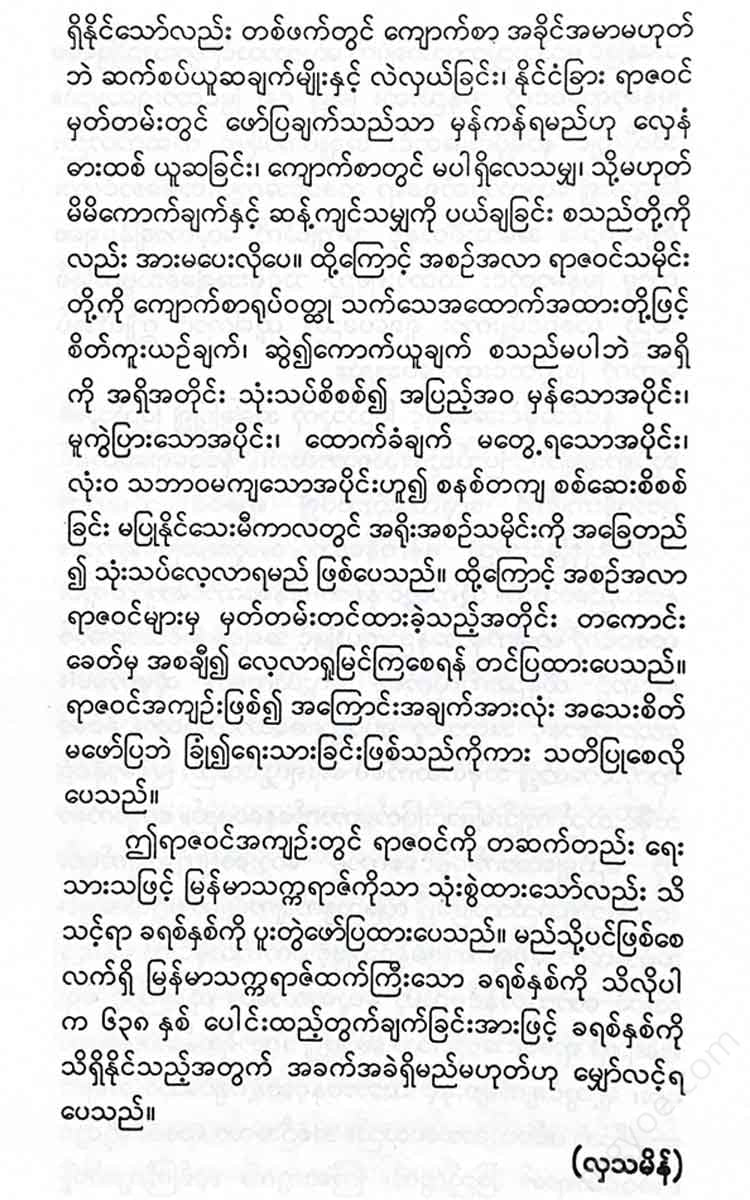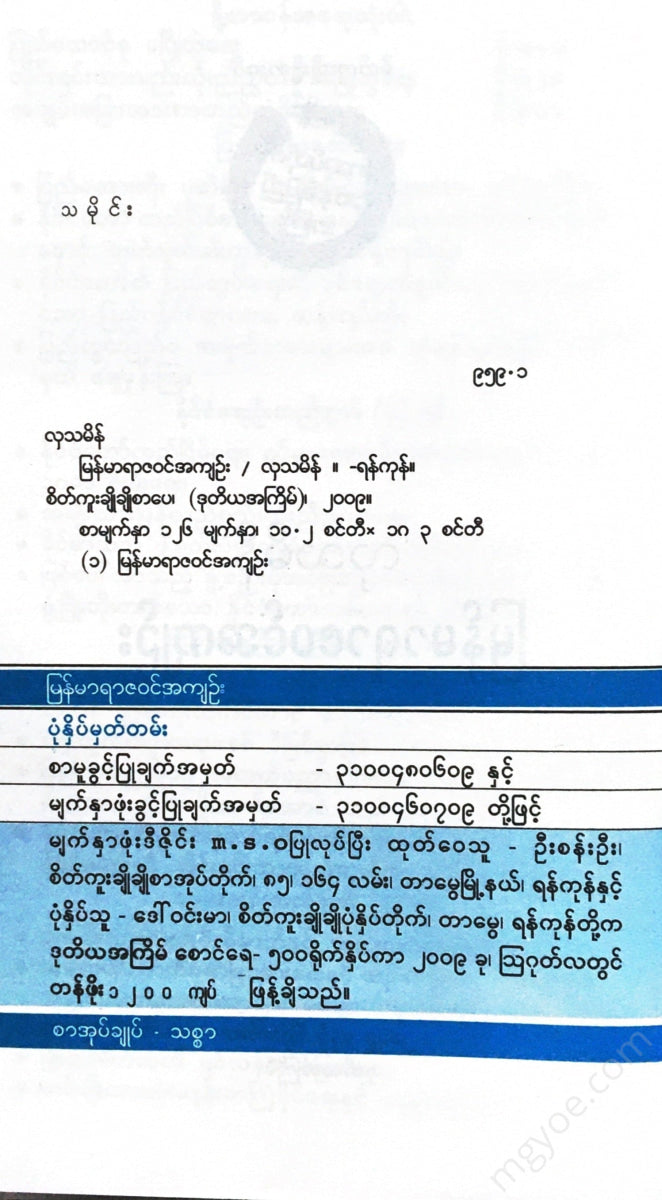စိတ်ကူးချိုချိုစာပေ
Hla Sa Main - Myanmar History
Hla Sa Main - Myanmar History
Couldn't load pickup availability
Brief history of Myanmar
As the saying goes, “Myanmar began with the Tagaung period.” The history of Myanmar is often described from the Tagaung period. If we look at the history of the establishment and rule of the country from generation to generation, we can trace it back to the Tagaung period. However, the fact that people began to settle in Myanmar thousands of years before the Tagaung period is clearly shown by the excavations of stone tools of the Stone Age people in various parts of Myanmar. These people must have been constantly migrating to the watery and grassy areas. They must have lived in groups. Finally, they reached the era of the Negrito people.
Then, the Mon, Khmer, Tibetan, and Thai Shan peoples from the Mongolian region of Central Asia, called Maungdaw, gradually entered and settled in northern Burma, while the Negrito peoples gradually migrated to the southern and southern sea peninsulas. The peoples who entered settled in each region and became separate ethnic groups, and their languages and customs also became different. The Mon people are descendants of the Mon, Khmer, Chin, Kachin, Kadu, Pyu, Kamyan, and Thet peoples are descendants of the Tibetan Burmese, and the Shan, Karen, Taung, and Padaung peoples are considered descendants of the Thai people. These peoples have always lived in groups and villages. The name Myanmar comes from the Pyu people, who appeared around the time of the Temkau period, and some believe that the Pyu people developed into the Burmese race.
During the time when tribes from Mongolia were settling in Myanmar, they first established a city and organized themselves in the Tagaung region on the right bank of the Ayeyarwady River and established themselves as kings. From there, they continued to rule for generations. The reason why they established a city and began to rule as kings in Tagaung is as follows.
The First Dynasty
More than 2800 years before the Buddha's birth, the Sakyan kings of Kapilavattura in India and the Pansala kings fought over the issue of lineage. The Sakyan king Koliya, who was a Sakyan, refused to accept the fact that he was a descendant of the Sakyans. The Pansala kings won the war and the Sakyans were divided into three clans. At that time, Abhiraga, a Sakyan king from Kapilavattura, traveled overland to northern Burma with an army and founded a city at Tagaung, where he ruled over the native Burmese people.
When King Abiraja passed away, his sons King Kamraja and King Kamraja fought for the throne. Following the advice of the nobles, they built a beautiful building overnight. King Kamraja succeeded to the throne overnight because he built it with small trees and bamboo.
King Kan Raja Gyi, however, crossed the Chindwin River and established a city at the foot of the Kalay Taung Nyo mountain, where he gathered his army for about six months. At that time, the Pyu people were living together in areas such as Hamlin and Sri Kshetra. The Pyu people requested him to rule over them, and he sent his son Mudusitta to rule over them.
King Kanraja founded the city of Kyaukpandaung (Kyaukpandaung) on the Kaladan River, east of the Kisapana River in northern Rakhine State, and then seized the old city of Dhanyawaddy, which had been founded by King Marayu, and established a dynasty in Rakhine State.
King Kanraja continued to rule in Tagaung and ruled through his descendants, resulting in 33 kings. These kings were:
1. Abijah,
2. His son, the young king,
3. His son, King Zambudipraja,
4. His son, Sankassaraja,
5. His son, Vipannaraja,
6. His son, Deva Taraza,
7. Uncle Munika Raja,
8. Brother Nagaraja,
9. His son, King Indra,
10. His son, Samutiraja,
11. His son, Devaraja,
12. His son Mahindra Raja,
13. His son, Vimalaraja,
14. His son, Sihanouk Raja,
15. His son, Manganaraja,
16. The fate of the son,
17. His son, the King of Kalinga,
18. His son, King Thindwe,
19. His brother, Sihanouk Raja,
20. His son, King Hamsa,
21. His son, Vararaja,
22. His son Alaung Raja,
23. His son, King Kolaka,
24. His son, Suriya Raja,
25. His son, King Thingyi Raja,
26. The beloved son of the king,
27. His son, Madhu Raja,
28. His son, King Min Hla Gyi Raja,
29. His son, Thansutthiharaja,
30. His son, Dhanangaraja,
31. His son, Hinaraja,
32. His son, Maurya Raja,
33. His son, King Beinaka,
It is said that during the reign of King Bainaka, the 33rd king of the first Tagaung era, the kingdom of Sankasaraththa Tagaung was destroyed by the Chinese invasion. The king gathered all the troops he could and took refuge in a remote place. When the king died there, the troops also dispersed.
Second Tagaung period
At that time, in India, King Passanadi Kosala of Savatthi asked King Mahanama of Kapilavatthu for a daughter to continue the dynasty. The Sakyans, fearing that the dynasty would be destroyed, did not give him a real princess. Instead, they gave her to their daughter, Princess Vasabhakattya, who was of a lower caste. Mahanama raised her as his wife, and she gave birth to a son, Vithalupa. When he grew up, Prince Vithalupa went to Kapilavatthu and began to play with his relatives. When the prince returned, the place where the prince sat was washed with milk, saying that he was a servant's son. When Prince Vithalupa heard this, he was ashamed and resentful. When he became king, he fought against the Sakyans, which destroyed the Sakyan dynasty for the second time.
King Dhajraja, a Sakyan king, came to Rakhine by sea and founded the city of Maurya. After crossing the Yoma mountain and ascending to the upper Anya, he met Nagasa, the wife of King Bhinnakara, who was a deity in the land of the dead. Since they were Sakyans, they married and founded the country of Anya Bagan. Soon after the birth of his son Viraja, he founded the city of Pansala (Pansa Tagaung) in the Tagaung region and reigned as King Thato Zambudipadhaja.
After that king passed away, 17 successive kings continued to rule. The second Tagaung dynasty kings are as follows.
1. The great sage,
2. The king of Thatoday,
3. The train is moving.
4. Tax increase,
5. To be a spearman,
6. Thato Hle (Thato Shwe),
7. The golden lotus,
8. The dragon,
9. Thato Naganai,
10. The Torah is the law.
11. Long-legged,
12. Stonehenge, year
13. As big as a elephant,
14. The elephant is tamed.
15. Every day, love.
16. King Thato,
17. Thato Maharaja,
King Satho Maharaja did not have a son, so he gave the throne to Queen Keenaravathi's brother Kepaduta. At that time, not only had the Buddha appeared in India, but also about 40 years had passed since the beginning of the Buddhist era, counting from the time he passed away.
One day, a wild boar was rampaging in the country of Tagaung, so Kepaduta took five weapons and set out to defeat the boar. He continued his pursuit for days, determined not to return to his homeland if he did not catch the boar. After a while, he reached an island near the land of Sri Kshetra, and was able to kill the boar. Then Kepaduta returned to his homeland.
Having no desire to return to the palace, he became a hermit and lived there, where the Pyu people of Sakya-in worshipped him. In the year that Kepaduta left the country of Tagaung, the king's wife gave birth to two blind twin sons, Mahasambava and Sula Sambhava.
The king was ashamed and had his sons hidden, but his mother took pity on them and hid them, so the king found out when they were adults. He had the princes killed again, but his mother refused to kill them, so they were floated on a raft down the Irrawaddy River. When they reached Salin on the way, the princes also received healing powers through medicine. As they continued their journey, they reached the port of Sri Kshetra, where the hermit U Rhee lived, and met the hermit's adopted daughter Bedari. They went to U Rhee. After telling her that they were related, in the 60th year of the Sathayana, Bedari and Mahasambhava were married.
